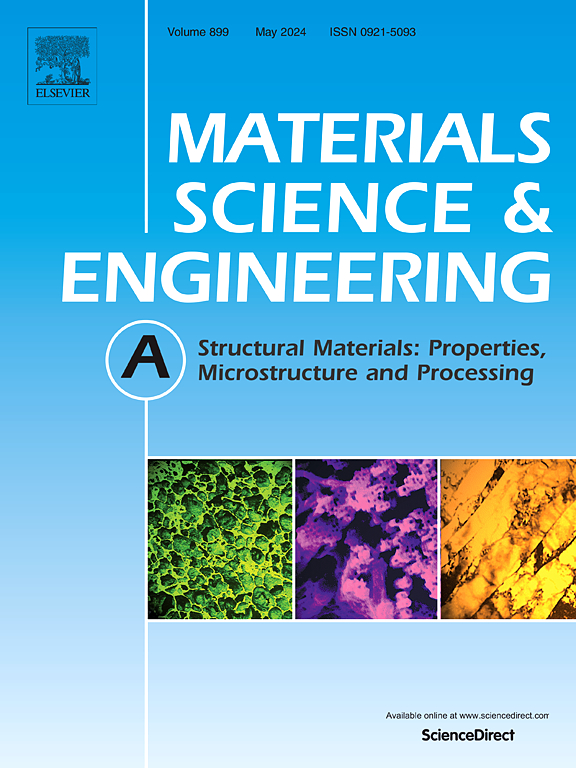高温力学性能优异的轻量化(Ti61Al16Cr10Nb8V5)99.6Si0.4多主合金组织演变及强化机制研究
IF 7
2区 材料科学
Q1 MATERIALS SCIENCE, MULTIDISCIPLINARY
引用次数: 0
摘要
本研究介绍了一种新型轻质多主合金(Ti61Al16Cr10Nb8V5)99.6Si0.4 (Ti61Si0.4),具有优异的高温力学性能。在室温下,轧制后的Ti61Si0.4合金主要为BCC/B2基体,晶粒等轴尺寸为36 μm,并伴有少量球形Ti3Al相(100-500 nm)和棒状Ti5Si3相(0.2-2 μm)。性能测试表明,Ti61Si0.4合金的密度为4.82 g/cm3,抗拉强度为1280 MPa,断裂应变为3.5%。在600°C、650°C和700°C条件下,合金的准静态抗拉强度和断裂应变分别为920 MPa和6.7%、750 MPa和16.3%、570 MPa和45%。显微组织观察表明,从600°C开始,BCC/B2向Ti3Al相转变;从650°C开始,BCC/B2向Ti3Al + TiCr2共晶转变。析出物通过位错旁通机制提高合金的强度。在600°C和700°C之间,应变速率从0.001/s到1/s的压缩试验显示出显著的应变速率强化效果,计算证实,合金的位错变形机制的变化是这种强化的主要原因。Arrhenius方程准确地描述了Ti61Si0.4合金在600 ~ 650℃范围内的变形行为。与高温钛合金相比,Ti61Si0.4合金在高温强度和比强度方面具有明显的优势,同时还保持了良好的室温加工性,在航空航天领域具有很大的应用潜力。本文章由计算机程序翻译,如有差异,请以英文原文为准。
A study on the microstructural evolution and strengthening mechanisms of the lightweight (Ti61Al16Cr10Nb8V5)99.6Si0.4 multi-principal alloy with excellent high-temperature mechanical properties
This study introduced a novel lightweight multi-principal alloy, (Ti61Al16Cr10Nb8V5)99.6Si0.4 (Ti61Si0.4), characterized by its superior high-temperature mechanical properties. At room temperature, the rolled Ti61Si0.4 alloy features BCC/B2 matrix with equiaxed grains of 36 μm, accompanied by small amounts of spherical Ti3Al phases (100–500 nm) and rod-like Ti5Si3 phases (0.2–2 μm). Performance testing showed that the Ti61Si0.4 alloy has density of 4.82 g/cm3, tensile strength of 1280 MPa, and fracture strain of 3.5 %. At 600 °C, 650 °C, and 700 °C, the alloy's quasi-static tensile strengths and fracture strains were measured at 920 MPa and 6.7 %, 750 MPa and 16.3 %, and 570 MPa and 45 %, respectively. Microstructural observations reveal a transformation from BCC/B2 to Ti3Al phase beginning at 600 °C and a eutectoid transformation from BCC/B2 to Ti3Al + TiCr2 beginning at 650 °C. Precipitations enhance the alloy's strength through a dislocation bypass mechanism. Compression tests at strain rates from 0.001/s to 1/s between 600 °C and 700 °C demonstrate significant strain rate strengthening effects, with calculations confirming that changes in the alloy's dislocation deformation mechanism are the primary cause of this strengthening. The Arrhenius equation accurately describes the deformation behavior of the Ti61Si0.4 alloy within the 600–650 °C range. Compared to high-temperature titanium alloys, Ti61Si0.4 alloy offers significant advantages in high-temperature strength and specific strength, while also maintaining good room-temperature workability, indicating great potential for applications in aerospace fields.
求助全文
通过发布文献求助,成功后即可免费获取论文全文。
去求助
来源期刊

Materials Science and Engineering: A
工程技术-材料科学:综合
CiteScore
11.50
自引率
15.60%
发文量
1811
审稿时长
31 days
期刊介绍:
Materials Science and Engineering A provides an international medium for the publication of theoretical and experimental studies related to the load-bearing capacity of materials as influenced by their basic properties, processing history, microstructure and operating environment. Appropriate submissions to Materials Science and Engineering A should include scientific and/or engineering factors which affect the microstructure - strength relationships of materials and report the changes to mechanical behavior.
 求助内容:
求助内容: 应助结果提醒方式:
应助结果提醒方式:


